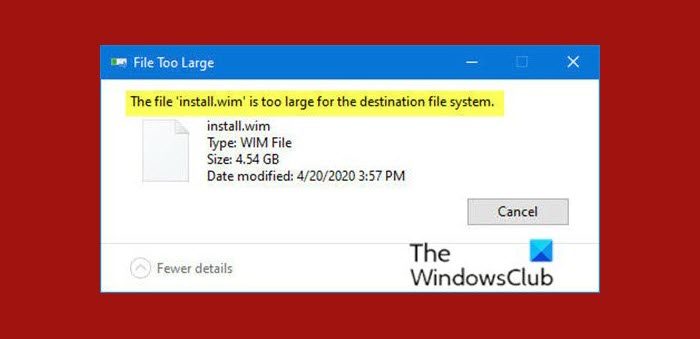If when you download the Windows ISO image and try to copy it to a bootable USB flash drive, but receive the error message The file ‘install.wim’ is too large for the destination file system, or Windows 11/10 ISO is too big for DVD, The disc image file is too large, then this post is intended to help you. In this post, we will explain why you encounter this error, as well as what you can do to get around the error.

The reason this File too large for the destination file system error occurs is that the Windows Imaging Format (WIM) file in that download, which contains the compressed files that the Windows Setup program uses for installing Windows 11/10, is a little over 4.5 GB in size, which is well beyond the 4 GB maximum file size for a USB flash drive formatted using the FAT32 file system.
Drives formatted using the NTFS file system can handle that extra-large file, but modern UEFI-based hardware requires a FAT32 drive to boot for a clean install of Windows.
The file ‘install.wim’ is too large for the destination file system
To get around this error on Windows 11/10, you could do any of the following:
- Mount the ISO as a virtual drive and run Setup from within Windows.
- Attach the ISO file as a virtual DVD drive in a virtual machine.
- Use various deployment tools to manage the installation over a network.
But if you require the option to run Setup from a bootable drive instead, so you can do a completely clean install, you’ll need to use the DISM command to split the WIM file into pieces that are under the 4 GB FAT32 size limit.
Here’s how in 4 steps:
- Create a bootable recovery drive
- Mount the downloaded ISO file and copy the contents to a folder on the local drive
- Use the DISM command to split the WIM file into multiple pieces
- Copy the installation files from your local folder to the bootable USB drive
Let’s see the steps in detail.
1] Create a bootable recovery drive
On a PC that’s already running Windows 10, plug in a USB flash drive and create a bootable drive using the Windows Recovery Media Creator. You’ll need a drive that’s at least 8 GB in size. Ensure that the Back up system files to the recovery drive option is unchecked. Bear in mind that all files on the drive will be erased when it’s formatted.
2] Mount the ISO file and copy its contents to a folder on the local drive
Press Winkey + E to open File Explorer and double-click the downloaded ISO file to mount it as a virtual drive. Leave that File Explorer window open and press Ctrl+N key combo to open a new window. In the new window, create a folder on a local hard disk and copy the contents of the mounted drive from the other window to that folder.
3] Use the DISM command to split the WIM file into multiple pieces
Now, press Winkey + R, type cmd and press CTRL+SHIFT+ENTER key combo to open Command Prompt in admin/elevated mode.
In the window, copy and paste the command below but replace the folder_name placeholder in the command with the name of the folder that you created in Step 2, and hit Enter.
Dism /Split-Image /ImageFile:C:\folder_name\sources\install.wim /SWMFile:C:\folder_name\sources\install.swm /FileSize:3800
After the operation completes, check the contents of the Sources folder. You should see two new files – Install.swm and Install2.swm, alongside the original Install.wim. You can now safely delete the Install.wim file from the folder you created.
4] Copy the installation files from your local folder to the bootable USB drive
Now, make sure you copy all (press CTRL+A, then press CTRL+C) the folders and files and paste them into the bootable USB flash drive. You’ll receive a prompt stating whether you want to replace files on the destination drive, click Yes.
This time, you shouldn’t receive the error. Windows Setup recognizes the two split files with the .SWM file name extensions and uses them to create the new installation.
Alternatively, if you’re not the type to roll up their sleeves and do some dirty work, you can use Rufus or any other application that can create a bootable USB flash drive. These tools format the drive by making 2 (or more) partitions. One of them formatted as NTFS another as FAT32. Both contain boot files, mapping to the installed OS on the NTFS partition. This way it can be booted from either a BIOS or a UEFI system.
UPDATE: Microsoft is removing the 32GB size limit for FAT32 partitions from the format command line in Windows 11. Although FAT supports volumes up to 2TB, Windows has a 32GB limit in place.
How do I change my FAT32 to NTFS?
- Open Disk Management
- Right-click the target device
- Select Format
- Set NTFS for the selected device
- Select Quick Format
- Click OK to confirm.
Wait for the process to complete.
I hope you find this post useful!